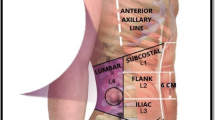Abstract
Purpose
To describe the eTEP approach for treating lateral primary and incisional hernia and show its results in a prospective series of cases.
Methods
A descriptive prospective study with patients treated surgically for lateral hernias using eTEP approach. Every patient was operated by the same surgeon from November 2018 to December 2021. Inclusion criteria were primary and incisional hernia, lateral and W1 and W2 sized using the EHS classification. Exclusion criteria were W3 hernia, loss of domain, need to remove previous mesh, dystrophic or ulcerative skin, history of previous complex surgery. Details of the surgical technique are described.
Results
34 patients were operated. Median age was 65 years old and BMI, 29.9 (22.1–47.1). There were several locations being the most frequent L3 in 18 patients. The median length was 41 mm (10–129) and width, 44 mm (10–97). The median of defect-mesh ratio was 5.05 (0.9–447.64). TAR was practised in 21 patients (61.8%). Only one patient suffered a clinically relevant complication, being a hematoma (Dindo–Clavien II). 50% of patients were operated in ambulatory surgery. After a median follow-up of 13.5 months, only one recurrence has been reported (2.9%).
Conclusion
eTEP to treat lateral hernias is feasible and reproducible showing good results in terms of hernia recurrence and complications. A further prospective randomized clinical trial is needed to support these results.







Similar content being viewed by others
References
Daes J (2012) The enhanced view-totally extraperitoneal technique for repair of inguinal hernia. Surg Endosc 26(4):1187–1189
Salido Fernandez S, FraileVilarrasa M, Osorio Silla I, GeorgievHristov T, Bernar de Oriol J, González-Ayora S, Pardo García R, Guadalajara Labajo H (2020) Extended totally extraperitoneal (eTEP) approach for ventral hernia repair: initial results. Cirugia Espanola 98(5):260–266
Belyansky I, Daes J, Radu VG, Balasubramanian R, Reza Zahiri H, Weltz AS, Sibia U, Park A, Novitsky Y (2018) A novel approach using the enhanced view totally extraperitoneal (eTEP) technique for laparoscopic retromuscular hernia repair. Surg Endosc 32(3):1525–1532
Radu VG, Lica M (2019) The endoscopic retromuscular repair of ventral hernia: the eTEP technique and early results. Hernia J Hernias Abdom Wall Surg 23(5):945–955
Hernia Surge Group (2018) International guidelines for groin hernia management. Hernia J Hernias Abdom Wall Surg 22(1):1–165
Muysoms FE, Miserez M, Berrevoet F, Campanelli G, Champault GG, Chelala E, Dietz UA, Eker HH, Nakadi I, Hauters P, Hidalgo Pascual M, Hoeferlin A, Klinge U, Montgomery A, Simmermacher R, Simons M, Smietanski M, Sommeling C, Tollens T, Vierendeels T, Kingsnoth A (2009) Classification of primary and incisional abdominal wall hernias. Hernia 13(4):407–414
Zhou DJ, Carlson MA (2018) Incidence, etiology, management, and outcomes of flank hernia: review of published data. Hernia J Hernias Abdom Wall Surg 22(2):353–361
Moreno-Egea A, Guzmán P, Morales G, Carrillo A, Aguayo JL (2007) Treatment of non-midline ventral hernia: experience in an abdominal wall unit and literature review. Cirugia Espanola 81(6):330–334
Cavalli M, Aiolfi A, Morlacchi A, Bruni PG, Del Ferraro S, Manfredini L, Campanelli G (2020) An extraperitoneal approach for complex flank, iliac, and lumbar hernia. Hernia 25(2):535–544
Belyansky I, Zahiri HR, Park A (2016) Laparoscopic transversus abdominis release, a novel minimally invasive approach to complex abdominal wall reconstruction. Surg Innov 23(2):134–141
LeBlanc KA, Booth WV (1993) Laparoscopic repair of incisional abdominal hernias using expanded polytetrafluoroethylene: preliminary findings. Surg Laparosc Endosc 3(1):39–41
Tulloh B, de Beaux A (2016) Defects and donuts: the importance of the mesh:defect area ratio. Hernia J Hernias Abdom Wall Surg 20(6):893–895
Author information
Authors and Affiliations
Corresponding author
Ethics declarations
Conflict of interest
Drs. Sergio Hernández-Villafranca, Siyuan Qian-Zhang, Irene Osorio Silla, ML Sánchez de Molina Rampérez, Enrique Calcerrada Alises, Carmen Sánchez, Ricardo Pardo, María Fraile Vilarrasa, Pedro Villarejo-Campos, Sergio Salido, have no conflicts of interest or financial ties to disclose.
Additional information
Publisher's Note
Springer Nature remains neutral with regard to jurisdictional claims in published maps and institutional affiliations.
Rights and permissions
About this article
Cite this article
Hernández-Villafranca, S., Qian-Zhang, S., Silla, I.O. et al. Extended totally extraperitoneal (eTEP) treatment for lateral primary and incisional hernias. New approach to old problems. Hernia 26, 1541–1549 (2022). https://doi.org/10.1007/s10029-022-02626-6
Received:
Accepted:
Published:
Issue Date:
DOI: https://doi.org/10.1007/s10029-022-02626-6




